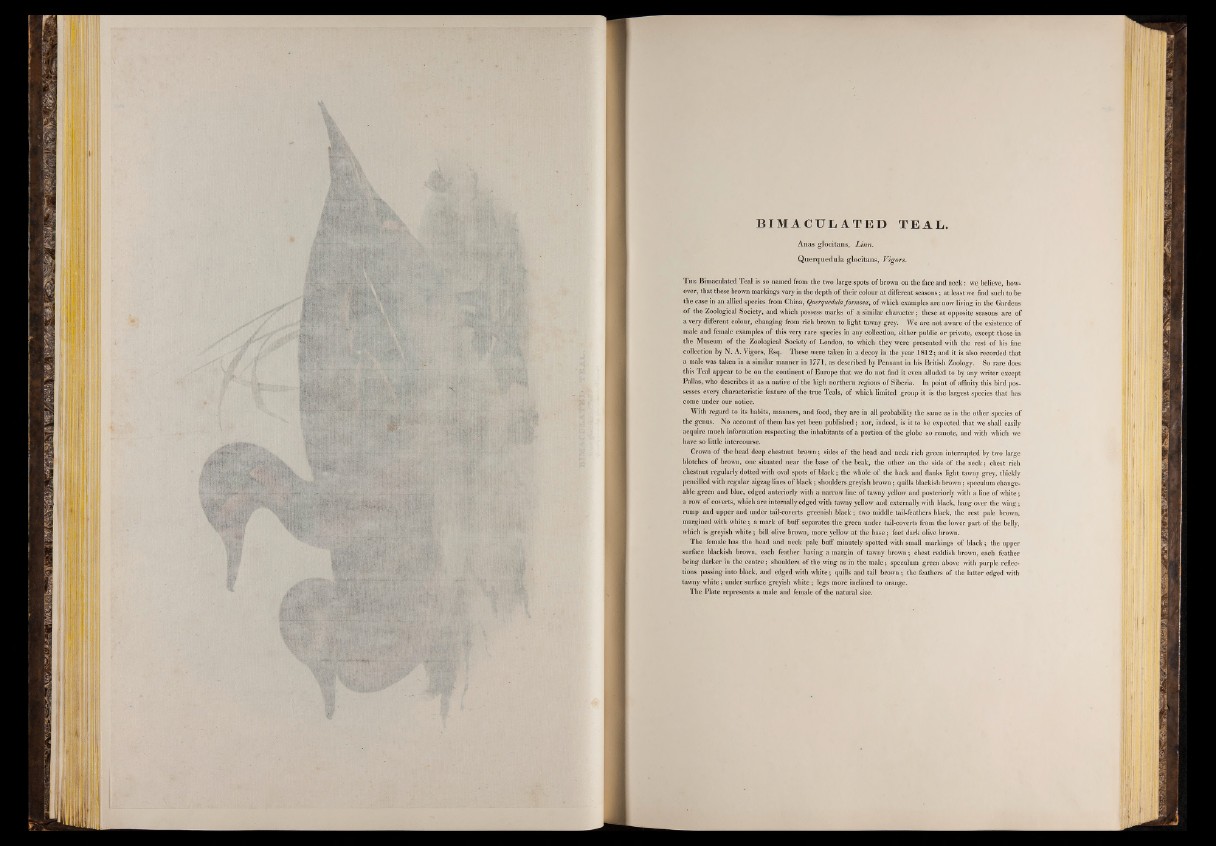
m m
B IM A C U L A T E D TEAL.
Anas glocitans, Linn.
Querquedula glocitans, Vigors.
T he Bimaculated Teal is so named from the two large spots of brown on the face and neck: we believe, however
, that these brown markings vary in the depth of their colour at different seasons; at least we find such to be
the case in an allied species from China, Querquedula formosa, of which examples are now living in the Cardens
o f the Zoological Society, and which possess marks of a similar character; these at opposite seasons are of
a very different colour, changing from rich brown to light tawny grey. We are not aware of the existence of
male and female examples of this very rare species in any collection, either public or private, except those in
the Museum of the Zoological Society of London, to which they were presented with the rest of his fine
collection by N. A. Vigors, Esq. These were taken in a decoy in the year 1812; and it is also recorded that
a male was taken in a similar manner in 1771, as described by Pennant in his British Zoology. So rare does
this Teal appear to be on the continent of Europe that we do not find it even alluded to by any writer except
Pallas, who describes it as a native of the high northern regions of Siberia. In point of affinity this bird possesses
every characteristic feature of the true Teals, of which limited group it is the largest species that has
come under our notice.
With regard to its habits, manners, and food, they are in all probability the same as in the other species of
the genus. No account of them has yet been published; nor, indeed, is it to be expected that we shall easily
acquire much information respecting the inhabitants of a portion of the globe so remote, and with which we
have so little intercourse.
Crown of the head deep chestnut brown; sides of the head and neck rich green interrupted by two large
blotches of brown, one situated near the base of the beak, the other on the side of the neck; chest rich
chestnut regularly dotted with oval spots of black; the whole of the back and flanks light tawny grey, thickly
pencilled with regular zigzag lines of black; shoulders greyish brown ; quills blackish brown; speculum changeable
green and blue, edged anteriorly with a narrow line of tawny yellow and posteriorly with a line of white;
a row of coverts, which are internally edged with tawny yellow and externally with black, hang over the wing;
rump and upper and under tail-coverts greenish black; two middle tail-feathers black, the rest pale brown,
margined with white; a mark of buff separates the green under tail-coverts from the lower part of the belly,
which is greyish white; bill olive brown, more yellow at the base; feet dark olive brown.
The female has the head and neck pale buff minutely spotted with small markings of black; the upper
surface blackish brown, each feather having a margin of tawny brown; chest reddish brown, each feather
being darker in the centre; shoulders of the wing as in the male; speculum green above with purple reflections
passing into black, and edged with white; quills and tail brown; the feathers of the latter edged with
tawny white; under surface greyish white; legs more inclined to orange.
The Plate represents a male and female of the natural size.